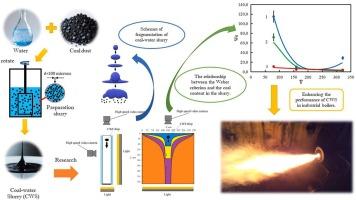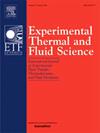Influence of the velocity gradient of the carrier medium on the crushing characteristics of non-Newtonian liquid droplets on the example of a highly concentrated coal-water suspension
IF 3.3
2区 工程技术
Q2 ENGINEERING, MECHANICAL
Experimental Thermal and Fluid Science
Pub Date : 2025-08-21
DOI:10.1016/j.expthermflusci.2025.111598
引用次数: 0
Abstract
The article presents the results of the experimental studies of the processes of fragmentation of coal-water slurry fuel (CWS) drops in an air flow. The directions of movement of the CWS drops and the air flow coincided. The effect of the velocity gradient () of the carrier medium (air) on the characteristics and conditions of CWS drop fragmentation was analyzed based on the experimental results. It was found that the values have a significant effect on the characteristics and conditions of CWS drop fragmentation. An increase in the velocity gradient of the carrier gas medium leads to a significantly nonlinear and nonmonotonic change in the critical Weber numbers for CWS drops of typical sizes in the case of using highly concentrated suspensions (with a coal component concentration in the fuel of φcoal = 50–55 %). The analysis of the effect of the coal type and its concentration in the water-coal suspension has shown that the characteristics and conditions of CWS drop fragmentation are significantly affected by the rheological properties of the water-coal fuel. It is shown that during fragmentation of drops of highly concentrated suspensions (at φcoal = 50–55 %) the dependence of the critical Weber number on the velocity gradient of the carrier medium flow demonstrates significant non-monotonicity and non-linearity. With an increase in the velocity gradient from s−1 to s−1 the values of the critical Weber number decrease (by 20 %), while a further increase in the velocity gradient leads to an increase in the Wecry values by 40 %. The latter is due to a significantly non-linear relationship between the rheological characteristics of the CWS and the concentration of coal, as well as the degree of its metamorphism. The hypothesis describing this non-trivial result has been developed. The hypothesis has been substantiated that the nature of the process of fragmentation of typical CWS drops is greatly influenced by a complex of hydrodynamic processes occurring inside the drop in the time period immediately preceding the fragmentation.

载体介质速度梯度对非牛顿液滴破碎特性的影响——以高浓度煤水悬浮液为例
本文介绍了水煤浆燃料在气流中破碎过程的实验研究结果。CWS的运动方向与气流方向一致。根据实验结果,分析了载体介质(空气)的速度梯度(∇V)对水煤浆液滴破碎特性和条件的影响。研究发现:∇V值对水煤浆液滴破碎的特性和条件有显著影响。在使用高浓度悬浮液(φ煤燃料中煤组分浓度为50 - 55%)的情况下,载气介质速度梯度的增加导致典型尺寸水煤浆滴的临界韦伯数发生显著的非线性和非单调变化。对水煤悬浮液中煤种及其浓度的影响分析表明,水煤燃料的流变性能显著影响水煤液滴破碎的特性和条件。结果表明,在高浓度悬浮液(φ煤= 50 ~ 55%)的破碎过程中,临界韦伯数与载体介质流速梯度的关系表现出显著的非单调性和非线性。随着速度梯度从gradV=80 s−1增加到gradV=160 s−1,临界韦伯数的值降低了20%,而速度梯度的进一步增加导致临界韦伯数增加了40%。后者是由于水煤浆的流变特性与煤的浓度及其变质程度之间存在显著的非线性关系。描述这一非平凡结果的假设已经被提出。这一假设已经得到证实,即典型水煤浆液滴破碎过程的性质在很大程度上受到破碎前一段时间内发生在液滴内部的复杂水动力过程的影响。
本文章由计算机程序翻译,如有差异,请以英文原文为准。
求助全文
约1分钟内获得全文
求助全文
来源期刊

Experimental Thermal and Fluid Science
工程技术-工程:机械
CiteScore
6.70
自引率
3.10%
发文量
159
审稿时长
34 days
期刊介绍:
Experimental Thermal and Fluid Science provides a forum for research emphasizing experimental work that enhances fundamental understanding of heat transfer, thermodynamics, and fluid mechanics. In addition to the principal areas of research, the journal covers research results in related fields, including combined heat and mass transfer, flows with phase transition, micro- and nano-scale systems, multiphase flow, combustion, radiative transfer, porous media, cryogenics, turbulence, and novel experimental techniques.
 求助内容:
求助内容: 应助结果提醒方式:
应助结果提醒方式:


